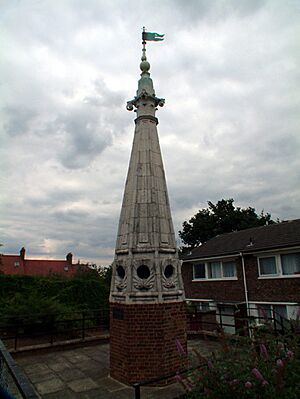St Antholin, Budge Row facts for kids
Quick facts for kids St Antholin, Budge Row |
|
|---|---|

St Antholin's, as rebuilt in the 17th century, Engraving c. 1830 by A. Cruse after Thomas Hosmer Shepherd.
|
|
| Location | London |
| Country | United Kingdom |
| Denomination | Anglican |
| Architecture | |
| Demolished | 1874 |
St Antholin, Budge Row was a historic church in the heart of London. It was also known as St Antholin, Watling Street. This church had a very long history, starting in the Middle Ages. It was rebuilt by the famous architect Sir Christopher Wren after the Great Fire of London in 1666. Sadly, the church built by Wren was taken down in 1874.
Contents
The First Church: A Medieval Beginning
The first records of St Antholin's church go all the way back to 1119. It was located in an area of London called Cordwainer Ward. The church stood on the north side of Budge Row, a street that no longer exists today. It was also near Sise Lane.
Originally, the church was called St Anthony's or St Anthonine's. It was named after a saint known as Anthony the Great.
Who Helped Build the Medieval Church?
The church was rebuilt or "re-edified" by Sir Thomas Knollys. He was the Mayor of London in 1399 and 1410. His son, also named Thomas, helped too. Both were buried inside the church. It seems the church was rebuilt again in 1513 by John Tate.
In 1616, the church had some repairs done. These repairs cost more than £900. In 1623, a beautifully decorated gallery was added. This gallery had 52 panels, and each panel showed a coat of arms.
Early Morning Lectures at St Antholin's
St Antholin's became famous for its early morning lectures. These talks started in 1559. To let everyone know a lecture was about to begin, the church bells would start ringing at 5 AM!
Rebuilding After the Great Fire
The original St Antholin's church was completely destroyed in the terrible Great Fire of London in 1666. After the fire, the church was rebuilt between 1678 and 1684. Sir Christopher Wren, a very famous architect, designed the new building.
The rebuilding cost £5,685. This money came from a special tax on coal and from donations. The parish of St Antholin's was joined with the parish of St John the Baptist upon Walbrook. That church was not rebuilt after the fire.
What Did Wren's Church Look Like?
The new church was about 66 feet (20 meters) long and 44 feet (13 meters) wide. Its tall tower and spire reached 154 feet (47 meters) high. The main part of the church looked quite simple from the outside. However, the steeple was very unique and detailed.
George Godwin, who wrote about churches in the 1800s, said the tower and spire were very inventive. He thought they had pleasing shapes. The stone spire was shaped like an octagon. It had different levels marked by horizontal ribs. There were also round ribs at the corners. The spire had openings at its base and was topped with a classical column design.
Inside, the church had an oval-shaped ceiling, like a dome. This ceiling was held up by eight columns. These columns stood on tall bases. Godwin also noted that the wooden roof showed how skilled Wren was at building. There was a small gallery at the west end with an organ. A round window was placed above the altar at the east end.
The Church in the 1800s
In 1829, the top part of the spire was replaced. The old top, including its dragon-shaped weather vane, was sold for £5. A printer named Robert Harrild bought it. He put it up at his home, Round Hill House, in Sydenham. You can still see it there today! It is now a Grade II listed structure, meaning it's protected for its historical importance.
The church itself was torn down in 1875. This happened because of a law called the Union of Benefices Act. The land was needed for a new street, Queen Victoria Street. When the church was demolished, many bodies buried in its crypt were moved. They were reburied at Brookwood Cemetery and the City of London Cemetery. The parish of St Antholin's was then combined with St Mary Aldermary.
A New St Antholin's in Nunhead

The land where the old church stood was sold for £44,990. Some of this money helped build a new St Antholin's church. This new church was built in Nunhead, a part of Peckham in south London. It was designed by Ewan Christian. The new building also received the beautiful altar screen from the old City church.
The new church was officially opened on May 11, 1878. During World War II, on December 27, 1940, it was badly damaged by fire bombs. However, it was rebuilt after the war. It was opened again on October 12, 1957, and renamed St Anthony, Nunhead.
In 1990, the parish of St Antholin's was combined with St Silas, Peckham Rye. In 2001, St Antholin's was no longer used as a church and was sold. In 2003, St Silas church was torn down and rebuilt on the same spot. It was then named St Antony and St Silas. Two bells from the old City church of St Antholin were hung in the new tower. One bell was made in 1717, and the other was recast in 1925 from the metal of another old bell.


